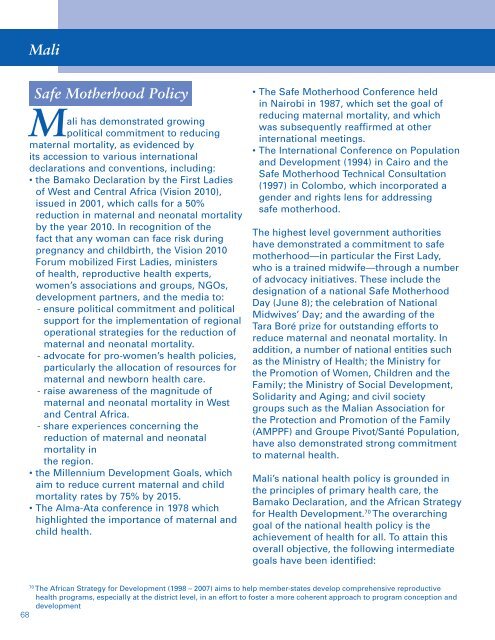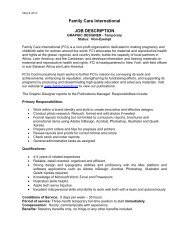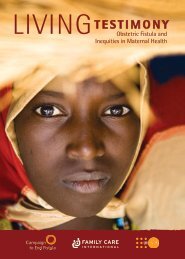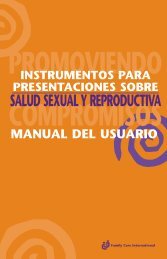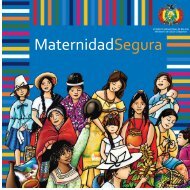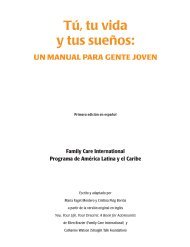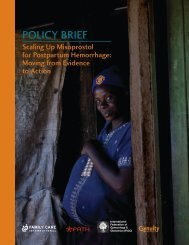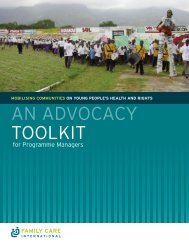Safe Motherhood: A Review - Family Care International
Safe Motherhood: A Review - Family Care International
Safe Motherhood: A Review - Family Care International
Create successful ePaper yourself
Turn your PDF publications into a flip-book with our unique Google optimized e-Paper software.
Mali<br />
<strong>Safe</strong> <strong>Motherhood</strong> Policy<br />
Mali has demonstrated growing<br />
political commitment to reducing<br />
maternal mortality, as evidenced by<br />
its accession to various international<br />
declarations and conventions, including:<br />
• the Bamako Declaration by the First Ladies<br />
of West and Central Africa (Vision 2010),<br />
issued in 2001, which calls for a 50%<br />
reduction in maternal and neonatal mortality<br />
by the year 2010. In recognition of the<br />
fact that any woman can face risk during<br />
pregnancy and childbirth, the Vision 2010<br />
Forum mobilized First Ladies, ministers<br />
of health, reproductive health experts,<br />
women’s associations and groups, NGOs,<br />
development partners, and the media to:<br />
- ensure political commitment and political<br />
support for the implementation of regional<br />
operational strategies for the reduction of<br />
maternal and neonatal mortality.<br />
- advocate for pro-women’s health policies,<br />
particularly the allocation of resources for<br />
maternal and newborn health care.<br />
- raise awareness of the magnitude of<br />
maternal and neonatal mortality in West<br />
and Central Africa.<br />
- share experiences concerning the<br />
reduction of maternal and neonatal<br />
mortality in<br />
the region.<br />
• the Millennium Development Goals, which<br />
aim to reduce current maternal and child<br />
mortality rates by 75% by 2015.<br />
• The Alma-Ata conference in 1978 which<br />
highlighted the importance of maternal and<br />
child health.<br />
• The <strong>Safe</strong> <strong>Motherhood</strong> Conference held<br />
in Nairobi in 1987, which set the goal of<br />
reducing maternal mortality, and which<br />
was subsequently reaffirmed at other<br />
international meetings.<br />
• The <strong>International</strong> Conference on Population<br />
and Development (1994) in Cairo and the<br />
<strong>Safe</strong> <strong>Motherhood</strong> Technical Consultation<br />
(1997) in Colombo, which incorporated a<br />
gender and rights lens for addressing<br />
safe motherhood.<br />
The highest level government authorities<br />
have demonstrated a commitment to safe<br />
motherhood—in particular the First Lady,<br />
who is a trained midwife—through a number<br />
of advocacy initiatives. These include the<br />
designation of a national <strong>Safe</strong> <strong>Motherhood</strong><br />
Day (June 8); the celebration of National<br />
Midwives’ Day; and the awarding of the<br />
Tara Boré prize for outstanding efforts to<br />
reduce maternal and neonatal mortality. In<br />
addition, a number of national entities such<br />
as the Ministry of Health; the Ministry for<br />
the Promotion of Women, Children and the<br />
<strong>Family</strong>; the Ministry of Social Development,<br />
Solidarity and Aging; and civil society<br />
groups such as the Malian Association for<br />
the Protection and Promotion of the <strong>Family</strong><br />
(AMPPF) and Groupe Pivot/Santé Population,<br />
have also demonstrated strong commitment<br />
to maternal health.<br />
Mali’s national health policy is grounded in<br />
the principles of primary health care, the<br />
Bamako Declaration, and the African Strategy<br />
for Health Development. 70 The overarching<br />
goal of the national health policy is the<br />
achievement of health for all. To attain this<br />
overall objective, the following intermediate<br />
goals have been identified:<br />
70 The African Strategy for Development (1998 – 2007) aims to help member-states develop comprehensive reproductive<br />
health programs, especially at the district level, in an effort to foster a more coherent approach to program conception and<br />
development


